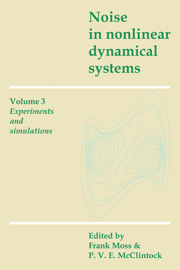Book contents
- Frontmatter
- Contents
- List of contributors
- Preface
- Introduction to Volume 3
- 1 The effects of colored quadratic noise on a turbulent transition in liquid He II
- 2 Electrohydrodynamic instability of nematic liquid crystals: growth process and influence of noise
- 3 Suppression of electrohydrodynamic instabilities by external noise
- 4 Colored noise in dye laser fluctuations
- 5 Noisy dynamics in optically bistable systems
- 6 Use of an electronic model as a guideline in experiments on transient optical bistability
- 7 Computer experiments in non-linear stochastic physics
- 8 Analogue simulations of stochastic processes by means of minimum component electronic devices
- 9 Analogue techniques for the study of problems in stochastic nonlinear dynamics
- Index
Introduction to Volume 3
Published online by Cambridge University Press: 05 January 2012
- Frontmatter
- Contents
- List of contributors
- Preface
- Introduction to Volume 3
- 1 The effects of colored quadratic noise on a turbulent transition in liquid He II
- 2 Electrohydrodynamic instability of nematic liquid crystals: growth process and influence of noise
- 3 Suppression of electrohydrodynamic instabilities by external noise
- 4 Colored noise in dye laser fluctuations
- 5 Noisy dynamics in optically bistable systems
- 6 Use of an electronic model as a guideline in experiments on transient optical bistability
- 7 Computer experiments in non-linear stochastic physics
- 8 Analogue simulations of stochastic processes by means of minimum component electronic devices
- 9 Analogue techniques for the study of problems in stochastic nonlinear dynamics
- Index
Summary
As will have become clear to readers of the first two volumes of Noise in Nonlinear Dynamical Systems, the theoretical development of the field, already extensive and wide-ranging, is still proceeding at a rapid pace. In fact, although such investigations were initiated as a means towards a better understanding of the observed properties of the physical world, the progress of the theory seems in many cases to have run far ahead of the corresponding experimental studies. Some important questions then arise. Does nature really behave in the manner predicted by the theory? Under what particular physical conditions is any given (approximate) theory to be relied upon? In most cases, these questions have no easy experimental answers, and the aim of this third volume is to survey the limited progress that has been made to date.
Credible experimental tests of stochastic theory have been completed on only a relatively small number of natural systems. These include, particularly, superfluid helium, liquid crystals and lasers, whose diverse properties provide the subject matter of Chapters 1–6.
Heat flow in superfluid helium can result in the formation of a tangle of quantized vortex lines, a particularly simple and well-characterized version of classical turbulence. The process occurs through a continuous instability of the type for which a variety of noise-induced transitions have been predicted. Chapter 1 describes a direct experimental test of these ideas.
The dramatic effect of external noise on liquid crystals is discussed in Chapters 2 and 3, which treat different aspects of the electrohydrodynamic instability (EHD).
- Type
- Chapter
- Information
- Noise in Nonlinear Dynamical Systems , pp. xv - xviPublisher: Cambridge University PressPrint publication year: 1989



